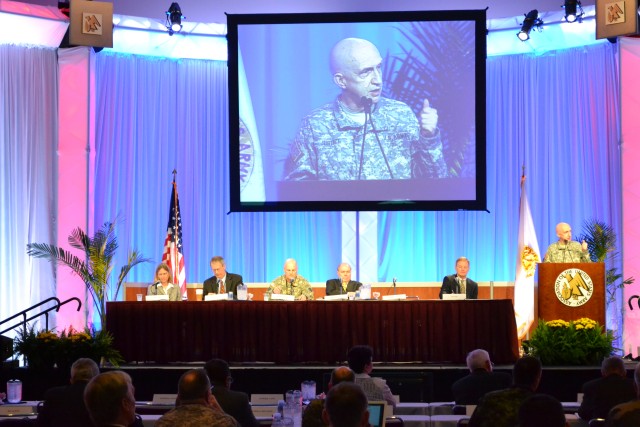FORT LAUDERDALE, Fla. -- Research and technology partnerships was the topic of discussion for a panel that included Maj. Gen. Nick Justice, commanding general for the U.S. Army Research, Development and Engineering Command, at a gathering of hundreds of members of the Army's science and technology community Feb. 23.
The panel was part of the Association of the United States Army's Institute of Land Warfare Winter Symposium and Exposition.
"Partnerships are about solving problems," Justice said opening his remarks.
Justice discussed successes and challenges created from partnerships fostered by RDECOM. He started by highlighting RDECOM's partners in education like the centers of excellence and university affiliated research centers. These are partnerships with universities across the country that allow RDECOM to work with university researchers in high-performance computing, materiel sciences and other technologies aimed to empower, unburden and protect the Warfighter.
"If we partner with these universities, we're going to get the opportunity to get the best and brightest minds of this generation working with us," Justice said.
He pointed out that despite the successes created with these university partnerships, there are still challenges that must be overcome.
"They know very little about our business. So, the challenge that we face is transitioning knowledge into technologies that we can integrate on the battlefield. That's where I think this community can help because you do similar things that we do," Justice said.
He noted that since industry promotes similar university partnerships, opportunities for collaboration arise. He suggested that there be a path for government and industry to discuss these partnerships and better synchronize the efforts both are making in support of the Soldier.
Justice also expounded on RDECOM's engineering partnerships. He spoke about the robotic programs and challenges spearheaded by RDECOM as well as its systems engineering centers. These centers are partnerships with universities that work specifically on systems engineering problems.
"The partnerships are set up with classic engineering schools and in locations very conducive for our research, development and engineering centers. Everywhere I have an RDEC, there is a partnered engineering school within proximity," Justice said.
Justice also discussed a few of the overreaching problems facing the Warfighter and the role the science and technology community can play in conquering these problems.
"We've got to deal with finding solutions to challenges and we have to identify the technologies that will help us overcome them," Justice said.
High-performance computers and the development of nanotechnologies provide opportunities to unburden the Warfighter by lightening the load he has to carry, according to Justice. He also stressed the importance of energy in battle.
"I think that one of the most prevailing issues on the battlefield today is power and energy. Being able to store it, generate it and have it available," Justice said.
The panel included five members of the Army's science and technology organizations, including Justice, and was chaired by Dr. Scott Fish, the U.S. Army's chief scientist.
"Everything that we do now is integrated. Having collaborations and partners among a number of organizations is easy to say. However, doing it well is not easy to do," Fish said.
The panelists joining Justice included Dr. John Cullinane, deputy director for the U.S. Army Engineer Research and Development Center; Brig. Gen. Patrick Donahue, director of the Concept Development and Learning, U.S. Army Capabilities Integration Center, Training and Doctrine Command; Dr. John Glenn, principal assistant for research and technology at the U.S. Army Medical Research and Materiel Command; and Dr. Michelle Sams, director for the U.S. Army Institute for the Behavioral and Social Sciences.


Social Sharing